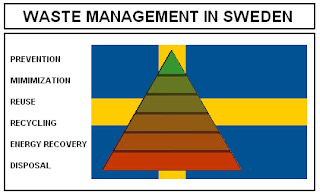Sweden has a garbage problem, but unlike the US and many other places in the world, Sweden's problem is not that there is too much trash, it is that there is too little. Thanks to Sweden's highly efficient recycling habits only four percent of the nations waste ends up in landfills.
This is in stark contrast to nations like the US where half of all waste ends up in landfills according to the US Environmental Protection Agency (EPA). Americans recycled just 34 percent of their waste in 2010, and a total of 136 million tons of garbage ended up in landfills. Americans throw away nearly half of their food, costing roughly $165 billion per year, according to a study by the Natural Resources Defense Council.
In Sweden it is mandatory for households to separate recyclables from trash, and producers help handle waste management.
The nation's innovative waste-to-energy program burns garbage to generates twenty percent of their district heating, a system of distributing heat by pumping heated water into pipes through residential and commercial buildings. It also provides electricity for a quarter of a million homes.
Sweden is so effective at managing waste that it has begun importing garbage to power its waste-to-energy program. The country is now importing 800,000 tons of trash each year from other European countries like Norway which pays Sweden to take the waste.
Together, Sweden's recycling programs and their waste-to-energy system ensures minimal environmental impact from the country’s waste. However, there is still some toxic waste left behind in the ash from incinerating garbage which are then returned to Norway.
According to Catarina Ostlund, Senior Advisor for the Swedish Environmental Protection Agency, Sweden has the world’s best incineration plants as far as energy efficiency is concerned. Nonetheless the nation continues to explore ways to reduce its own waste even further.
“This is not a long-term solution really, because we need to be better to reuse and recycle, but in the short perspective I think it’s quite a good solution,” Ostlund concluded
Sweden is a model of waste management that other countries can learn from. Their radically efficient circle of consumption, waste management, and energy output are a model for a more sustainable future.
It appears that other countries are following Sweden's example with new waste-to-energy initiatives in Italy, Romania, Bulgaria, and Lithuania. Only a very small amount of trash is incinerated in the US.
© 2013, Richard Matthews. All rights reserved.
Related Posts
E-Waste: A New Business Opportunity
Evolving Metrics for Corporate Sustainability: Beyond Waste
Recycling In America: More Than Just A Feel Good Experience
The Growing Problem of Cell Phone Waste
Greenpeace e-Waste Investigation (Video)
The Problems and Solutions of e-Waste (Video)
US e-waste is Polluting Toxic Dumps in Ghana (Video)
The US Desire to be "Green" is Causing an e-Waste Hell China (Video)
Recycling Waste Tires
The Waste Hydrogen Utilization Project
Video: The Perils of Plastic Waste
Home
discard
effluent
garbage
landfill
Reuse
rid
throw away
throw out
trash
use
utilization
Sweden is a Model of Sustainable Waste Management
- Blogger Comment
- Facebook Comment
Subscribe to:
Post Comments
(
Atom
)

0 comments:
Post a Comment